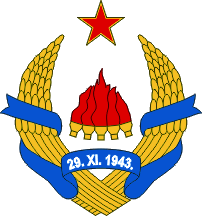State Anti-fascist Council for the National Liberation of Croatia

The State Anti-fascist Council for the National Liberation of Croatia (Serbo-Croatian: Zemaljsko antifašističko vijeće narodnog oslobođenja Hrvatske), often referred to by the acronym ZAVNOH, was the highest governing organ of the anti-fascist movement in Croatia during World War II. It was developed to be the bearer of Croatian statehood. At its last meeting, it changed its name to the People's Parliament of Croatia (Narodni sabor Hrvatske).
Sessions
Initiative committee
Preparations for the foundation of ZAVNOH started on December 5, 1942 when the Croatian representatives in AVNOJ requested the districtual boards to delegate members of the future Initiative Committee of the State Antifascist Council of National Liberation of Croatia. After the delegates were named the Initiative Committee was constituted in Ponor on March 1, 1943 near Korenica in Lika.
1st session

Held June 13 (in Otočac) and June 14, 1943 (on Plitvice Lakes) was the founding session of ZAVNOH. Vladimir Nazor was chosen president. ZAVNOH adopted "Proclamation to Peoples of Croatia" ("Proglas narodima Hrvatske" in Croatian) and "Resolution" (often called "Plitvice Resolution"). Resolution stated that ZAVNOH was highest political authority of anti-fascist movement in Croatia. Executive board ("Izvršni odbor" in Croatian, abbr. IO ZAVNOH) of 11 members was elected to perform duties of ZAVNOH between sessions.
As the representative of the Allied Command major William M. Jones (Lawrence of Yugoslavia) was present at the founding session. Also the representative of the Liberation Front of the Slovenian People, Jana Jernej was present.
2nd session
The second session was held October 12–15, 1943 in Plaški. In this session an executive board of 15 members was elected and the decision of Executive Board of ZAVNOH made on September 20, 1943 was confirmed. "Ordinance About Interior Organisation and Work of ZAVNOH" was adopted as well as the Secretariat of ZAVNOH was founded; which ruled Croatian affairs as a de facto government.
At the Second and Third sessions the equality of the Serbian and Croatian nations, as constituent nations of the federal unit of Croatia, was recognized in every aspect.[1]
3rd session
The third session occurred on May 8 and May 9, 1944 in Topusko, and was sometimes referred to as the Sabor u Topuskom ("Assembly in Topusko"). The third session of ZAVNOH formally formed the Federal State of Croatia. Newly adopted "Rules of conduct of ZAVNOH" disbanded IO (Executive Board) and formed 31 member Presidium of ZAVNOH. The following were established at this session:
- Authorization of Croatian delegates on the 2nd AVNOJ meeting to represent Croatia
- Proclamation of ZAVNOH as the supreme legislative and executive organ of government of Federal State of Croatia
- Declaration of basic rights of peoples and citizens of the Federal State of Croatia:
- The Croat and Serb people in Croatia are equal in every way. The National minorities in Croatia will have guaranteed human rights.
- All citizens of Croatia are equal in the eyes of the law, regardless of their nationality, race and religion
- Women have the same rights as men
- Every citizen is guaranteed personal and property security. The right of ownership and private initiatives are guaranteed.
- Decision about structure and operations of NOOs and assemblies in Federal State of Croatia
- Rules of conduct of ZAVNOH
4th session
- The final session occurred on August 21, 1945 in Zagreb (in building of Croatian Parliament). Here, the ZAVNOH renamed itself the National Parliament of Croatia.
ZAVNOH between sessions
- On September 20, 1943, the Executive Board of ZAVNOH issued a decision to return Istria, Zadar, Cres, Lastovo and other parts of Croatia which were ceded to fascist Italy by Independent State of Croatia.
- ZAVNOH operated in the City of Šibenik from December 31, 1944 to May 13, 1945, before moving to Zagreb on May 20, 1945.
- The first People's Government of Croatia (led by Vladimir Bakarić) was founded at the extraordinary session of the Presidency of ZAVNOH, which was held on April 14, 1945 in Split.
Constitution of Croatia on ZAVNOH
The Preamble ("Historical Foundations") of the Constitution of the Republic of Croatia states:
The millennial national identity of the Croatian nation and the continuity of its statehood, confirmed by the course of its entire historical experience in various political forms and by the perpetuation and development of the state-building idea grounded in the historical right of the Croatian nation to full sovereignty, has manifested itself:
[...]
in the establishment of the foundations of state sovereignty during the course of the Second World War, as expressed in the decision of the State Antifascist Council of the National Liberation of Croatia (1943) in opposition to proclamation of the Independent State of Croatia (1941), and then in the Constitution of the People’s Republic of Croatia (1947) and in all subsequent constitutions of the Socialist Republic of Croatia (1963-1990), at the historic turning-point characterized by the rejection of the communist system and changes in the international order in Europe, in the first democratic elections (1990), the Croatian nation reaffirmed, by its freely expressed will, its millennial statehood
— Historical Foundations, Constitution of the Republic of Croatia[2]
Presidency
In May 1944, the ZAVNOH was led by a ten-member presidency:[3]
- Vladimir Nazor (independent, poet)
- Andrija Hebrang (KPJ)
- Ivan Gošnjak (KPJ)
- Franjo Gaži (HSS)
- Stjepan Prvčić (HSS)
- Filip Lakuš (HSS)
- Rade Pribićević (SDS)
- Simo Error (SDS)
- Svetozar Rittig (Catholic priest)
- Ante Mandić (independent)
References
- ↑ Yugoslavia Through Documents: From Its Creation to Its Dissolution edited by Snežana Trifunovska, page 477, it says: "at the Second and Third sessions of the National Anti-Fascist Council of the Peoples Liberation of Croatia (ZAVNOH),...,the equality of the Serbian and the Croatian nations, as constituent nations of the federal unit of Croatia, were recognized in every respect."
- ↑ "Historical Foundations". The Constitution of the Republic of Croatia (consolidated text). Croatian Parliament. Retrieved 2011-02-16.
- ↑ Ivanković-Vonta, Zvonko (1988). Hebrang. Bibliotheca Scientia Yugoslavica. p. 255. ISBN 86-81183-03-6.
